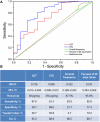Hair Zidovudine Concentrations Predict Virologic Outcomes Among People Living with HIV/AIDS in China
- PMID: 35945983
- PMCID: PMC9357394
- DOI: 10.2147/PPA.S371623
Hair Zidovudine Concentrations Predict Virologic Outcomes Among People Living with HIV/AIDS in China
Abstract
Background: Hair antiretroviral concentrations are an objective and non-invasive measure of adherence to long-term antiretroviral therapy (ART) and can further predict virologic outcomes among people living with HIV/AIDS (PLWH). Zidovudine, one of the mainstream antiretrovirals in China, has been verified to have high reliability in adherence assessment, especially for its hair concentrations. However, data are limited in its predicting virologic outcomes. Therefore, this study aimed to characterize whether hair zidovudine concentrations can predict virologic suppression among Chinese PLWH compared with hair lamivudine concentrations and two self-reported measures, the overall frequency of adherence behaviors and percentage adherence.
Methods: This cross-sectional study randomly recruited 564 PLWH currently treated with zidovudine, lamivudine, and other ART agents (efavirenz, nevirapine, or lopinavir/ritonavir) in Guangxi, China. Hair antiretroviral concentrations were determined using the LC-ESI+-MS/MS method. Receiver operating characteristic (ROC) curves were used to estimate the optimal classification thresholds of hair concentrations of zidovudine and lamivudine, and the two self-reported measures. Based on those optimal classification thresholds, logistic regression was used to examine whether those four adherence measures can predict virologic suppression (HIV-1 RNA <200 copies/mL).
Results: ROC curves demonstrated good classification performance for association with virologic suppression of zidovudine with the optimal threshold at 58 pg/mg and lamivudine at 255 pg/mg but no self-reported measures. PLWH with hair zidovudine concentrations >58 pg/mg had an adjusted odds ratio (aOR) of 43.191 (95% confidence interval (CI) = 10.171‒183.418, p < 0.001) for virologic suppression. Hair lamivudine concentrations were also associated with virologic suppression (aOR = 10.656, 95% CI = 3.670‒30.943, p < 0.001). However, two self-reported measures did not predict virologic suppression (aORs = 1.157 and 2.488, ps >0.149).
Conclusion: Hair zidovudine concentrations can be served as an alternative tool for clinically predicting virologic suppression among PLWH in China.
Keywords: LC-MS/MS; PLWH; hair antiretroviral concentrations; virologic suppression; zidovudine.
© 2022 Wu et al.
Conflict of interest statement
The authors report no conflicts of interest in the work.
Figures
Similar articles
-
Hair levels of steroid, endocannabinoid, and the ratio biomarkers predict viral suppression among people living with HIV/AIDS in China.Clin Chim Acta. 2022 Oct 1;535:143-152. doi: 10.1016/j.cca.2022.08.023. Epub 2022 Aug 27. Clin Chim Acta. 2022. PMID: 36041548
-
Association of Hair Concentrations of Antiretrovirals with Virologic Outcomes Among People Living with HIV in Guangxi, China.Patient Prefer Adherence. 2021 Apr 23;15:853-861. doi: 10.2147/PPA.S277965. eCollection 2021. Patient Prefer Adherence. 2021. PMID: 33935495 Free PMC article.
-
Antiretroviral drug concentrations in hair are associated with virologic outcomes among young people living with HIV in Tanzania.AIDS. 2018 Jun 1;32(9):1115-1123. doi: 10.1097/QAD.0000000000001788. AIDS. 2018. PMID: 29438196 Free PMC article.
-
Lamivudine Concentration in Hair and Prediction of Virologic Failure and Drug Resistance among HIV Patients Receiving Free ART in China.PLoS One. 2016 Apr 27;11(4):e0154421. doi: 10.1371/journal.pone.0154421. eCollection 2016. PLoS One. 2016. PMID: 27119346 Free PMC article.
-
Factors associated with viral suppression and rebound among adult HIV patients on treatment: a retrospective study in Ghana.AIDS Res Ther. 2022 May 25;19(1):21. doi: 10.1186/s12981-022-00447-2. AIDS Res Ther. 2022. PMID: 35614510 Free PMC article. Review.
Cited by
-
Discrepancies between self-reported medication in adherence and indirect measurement adherence among patients undergoing antiretroviral therapy: a systematic review.Infect Dis Poverty. 2024 Jul 5;13(1):51. doi: 10.1186/s40249-024-01221-4. Infect Dis Poverty. 2024. PMID: 38970140 Free PMC article.
References
LinkOut - more resources
Full Text Sources


